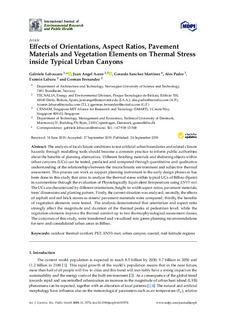| dc.contributor.author | Lobaccaro, Gabriele | |
| dc.contributor.author | Acero, Juan Angel | |
| dc.contributor.author | Sanchez Martinez, Gerardo | |
| dc.contributor.author | Ales, Padro | |
| dc.contributor.author | Laburu, Txomin | |
| dc.contributor.author | Fernandez, German | |
| dc.date.accessioned | 2019-09-30T05:51:44Z | |
| dc.date.available | 2019-09-30T05:51:44Z | |
| dc.date.created | 2019-09-29T08:29:43Z | |
| dc.date.issued | 2019 | |
| dc.identifier.citation | International Journal of Environmental Research and Public Health. 2019, 16 (19), 1-29. | nb_NO |
| dc.identifier.issn | 1660-4601 | |
| dc.identifier.uri | http://hdl.handle.net/11250/2619255 | |
| dc.description.abstract | The analysis of local climate conditions to test artificial urban boundaries and related climate hazards through modelling tools should become a common practice to inform public authorities about the benefits of planning alternatives. Different finishing materials and sheltering objects within urban canyons (UCs) can be tested, predicted and compared through quantitative and qualitative understanding of the relationships between the microclimatic environment and subjective thermal assessment. This process can work as support planning instrument in the early design phases as has been done in this study that aims to analyze the thermal stress within typical UCs of Bilbao (Spain) in summertime through the evaluation of Physiologically Equivalent Temperature using ENVI-met. The UCs are characterized by different orientations, height-to-width aspect ratios, pavement materials, trees’ dimensions and planting pattern. Firstly, the current situation was analyzed; secondly, the effects of asphalt and red brick stones as streets’ pavement materials were compared; thirdly, the benefits of vegetation elements were tested. The analysis demonstrated that orientation and aspect ratio strongly affect the magnitude and duration of the thermal peaks at pedestrian level; while the vegetation elements improve the thermal comfort up to two thermophysiological assessment classes. The outcomes of this study, were transferred and visualized into green planning recommendations for new and consolidated urban areas in Bilbao. | nb_NO |
| dc.language.iso | eng | nb_NO |
| dc.publisher | MDPI | nb_NO |
| dc.relation.uri | https://www.mdpi.com/1660-4601/16/19/3574/htm | |
| dc.rights | Navngivelse 4.0 Internasjonal | * |
| dc.rights.uri | http://creativecommons.org/licenses/by/4.0/deed.no | * |
| dc.subject | Urban design | nb_NO |
| dc.subject | Urban Design | nb_NO |
| dc.subject | Termisk komfort | nb_NO |
| dc.subject | Thermal comfort | nb_NO |
| dc.subject | Byplanlegging | nb_NO |
| dc.subject | Urban planning | nb_NO |
| dc.subject | Klimatiltak | nb_NO |
| dc.subject | Climate mitigation | nb_NO |
| dc.title | Effects of Orientations, Aspect Ratios, Pavement Materials and Vegetation Elements on Thermal Stress inside Typical Urban Canyons | nb_NO |
| dc.type | Journal article | nb_NO |
| dc.type | Peer reviewed | nb_NO |
| dc.description.version | publishedVersion | nb_NO |
| dc.subject.nsi | VDP::Miljøteknologi: 610 | nb_NO |
| dc.subject.nsi | VDP::Environmental engineering: 610 | nb_NO |
| dc.source.pagenumber | 1-29 | nb_NO |
| dc.source.volume | 16 | nb_NO |
| dc.source.journal | International Journal of Environmental Research and Public Health | nb_NO |
| dc.source.issue | 19 | nb_NO |
| dc.identifier.doi | 10.3390/ijerph16193574 | |
| dc.identifier.cristin | 1730684 | |
| dc.relation.project | EC/FP7/308497 | nb_NO |
| dc.relation.project | COST (European Cooperation in Science and Technology): TU0902 | nb_NO |
| dc.description.localcode | © 2019 by the authors. Licensee MDPI, Basel, Switzerland. This article is an open access article distributed under the terms and conditions of the Creative Commons Attribution (CC BY) license (http://creativecommons.org/licenses/by/4.0/). | nb_NO |
| cristin.unitcode | 194,61,55,0 | |
| cristin.unitname | Institutt for arkitektur og teknologi | |
| cristin.ispublished | true | |
| cristin.fulltext | original | |
| cristin.qualitycode | 1 | |

